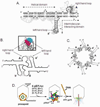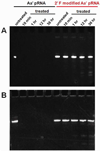Fabrication of stable and RNase-resistant RNA nanoparticles active in gearing the nanomotors for viral DNA packaging
- PMID: 21155596
- PMCID: PMC3026857
- DOI: 10.1021/nn1024658
Fabrication of stable and RNase-resistant RNA nanoparticles active in gearing the nanomotors for viral DNA packaging
Abstract
Both DNA and RNA can serve as powerful building blocks for bottom-up fabrication of nanostructures. A pioneering concept proposed by Ned Seeman 30 years ago has led to an explosion of knowledge in DNA nanotechnology. RNA can be manipulated with simplicity characteristic of DNA, while possessing noncanonical base-pairing, versatile function, and catalytic activity similar to proteins. However, standing in awe of the sensitivity of RNA to RNase degradation has made many scientists flinch away from RNA nanotechnology. Here we report the construction of stable RNA nanoparticles resistant to RNase digestion. The 2'-F (2'-fluoro) RNA retained its property for correct folding in dimer formation, appropriate structure in procapsid binding, and biological activity in gearing the phi29 nanomotor to package viral DNA and producing infectious viral particles. Our results demonstrate that it is practical to produce RNase-resistant, biologically active, and stable RNA for application in nanotechnology.
Figures










Similar articles
-
A simple mathematical formula for stoichiometry quantification of viral and nanobiological assemblage using slopes of log/log plot curves.J Virol Methods. 2004 Jan;115(1):19-30. doi: 10.1016/j.jviromet.2003.08.015. J Virol Methods. 2004. PMID: 14656457
-
Grouping of ferritin and gold nanoparticles conjugated to pRNA of the phage phi29 DNA-packaging motor.J Nanosci Nanotechnol. 2007 Sep;7(9):3257-67. doi: 10.1166/jnn.2007.914. J Nanosci Nanotechnol. 2007. PMID: 18019159
-
Fabrication of pRNA nanoparticles to deliver therapeutic RNAs and bioactive compounds into tumor cells.Nat Protoc. 2013 Sep;8(9):1635-59. doi: 10.1038/nprot.2013.097. Epub 2013 Aug 1. Nat Protoc. 2013. PMID: 23928498 Free PMC article.
-
Assembly of multifunctional phi29 pRNA nanoparticles for specific delivery of siRNA and other therapeutics to targeted cells.Methods. 2011 Jun;54(2):204-14. doi: 10.1016/j.ymeth.2011.01.008. Epub 2011 Feb 12. Methods. 2011. PMID: 21320601 Free PMC article. Review.
-
Structure and function of phi29 hexameric RNA that drives the viral DNA packaging motor: review.Prog Nucleic Acid Res Mol Biol. 2002;72:415-72. doi: 10.1016/s0079-6603(02)72076-x. Prog Nucleic Acid Res Mol Biol. 2002. PMID: 12206459 Review.
Cited by
-
RNA Nanoparticles Derived from Three-Way Junction of Phi29 Motor pRNA Are Resistant to I-125 and Cs-131 Radiation.Nucleic Acid Ther. 2015 Aug;25(4):188-97. doi: 10.1089/nat.2014.0525. Epub 2015 May 27. Nucleic Acid Ther. 2015. PMID: 26017686 Free PMC article.
-
Construction of RNA-Quantum Dot Chimera for Nanoscale Resistive Biomemory Application.ACS Nano. 2015 Jul 28;9(7):6675-82. doi: 10.1021/acsnano.5b03269. Epub 2015 Jul 13. ACS Nano. 2015. PMID: 26135474 Free PMC article.
-
Dynamic RNA synthetic biology: new principles, practices and potential.RNA Biol. 2023 Jan;20(1):817-829. doi: 10.1080/15476286.2023.2269508. Epub 2023 Dec 3. RNA Biol. 2023. PMID: 38044595 Free PMC article. Review.
-
3D RNA-scaffolded wireframe origami.Nat Commun. 2023 Jan 24;14(1):382. doi: 10.1038/s41467-023-36156-1. Nat Commun. 2023. PMID: 36693871 Free PMC article.
-
Nucleic acid nanostructures for in vivo applications: The influence of morphology on biological fate.Appl Phys Rev. 2023 Mar;10(1):011304. doi: 10.1063/5.0121820. Appl Phys Rev. 2023. PMID: 36874908 Free PMC article. Review.
References
-
- Aldaye FA, Palmer AL, Sleiman HF. Assembling Materials With DNA As the Guide. Science. 2008;321:1795–1799. - PubMed
-
- Glotzer SC. Materials Science. Some Assembly Required. Science. 2004;306:419–420. - PubMed
-
- Gates BD, Xu Q, Stewart M, Ryan D, Willson CG, Whitesides GM. New Approaches to Nanofabrication: Molding, Printing, and Other Techniques. Chem. Rev. 2005;105:1171–1196. - PubMed
Publication types
MeSH terms
Substances
Grants and funding
LinkOut - more resources
Full Text Sources
Other Literature Sources

